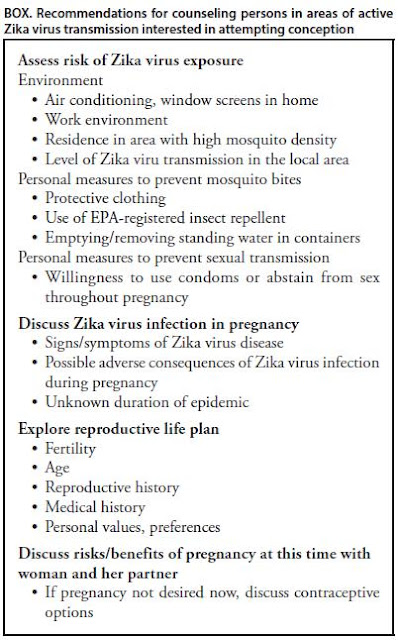# 11,198
Although Zika's impact on the United States has been limited so far, with summer not far off, that is likely to change. The CDC continues to plan and prepare for whatever the virus might have in store, and has produced an enormous amount of guidance over the past couple of months.
Today, the CDC scheduled a late afternoon press conference to announce 3 new MMWR interim guidance documents. Audio and transcripts will be posted on the CDC Media site when they become available.
Below you'll find the CDC's description of these three documents, and a few quick snips. You'll definitely want to follow the links to get the full content.
High
rates of unintended and adolescent pregnancies in Puerto Rico suggest that, in
the context of this outbreak, access to contraception could be improved. CDC
estimates that 138,000 women of childbearing age (aged 15–44 years) in Puerto
Rico do not desire pregnancy and are not using one of the most effective or
moderately effective contraceptive methods, and therefore might experience an
unintended pregnancy. CDC and other federal and local partners are seeking to
expand access to contraception for these women. Such efforts have the potential
to increase contraceptive access and use, reduce unintended pregnancies, and
lead to fewer adverse pregnancy and birth outcomes associated with Zika virus
infection during pregnancy. The assessment of challenges and resources related
to contraceptive access in Puerto Rico may be a useful model for other areas
with local transmission of Zika virus.
Update: Interim Guidelines for Prevention of Sexual Transmission of Zika Virus — United States, 2016
CDC issued interim
guidelines for the prevention of sexual transmission of Zika virus on February
5, 2016. The following updated recommendations apply to men who have traveled to
or reside in areas with ongoing mosquito-borne Zika virus transmission
(http://wwwnc.cdc.gov/travel/notices/) and their female or
male sex partners. These recommendations replace the previously issued
recommendations and are updated to include time intervals after travel to areas
with ongoing Zika virus transmission or after Zika virus infection for taking
precautions to reduce the risk of sexual transmission. These guidelines define
potential sexual exposure to Zika virus as any person who has had sex without a
condom (i.e., vaginal intercourse, anal intercourse, or fellatio) with a man who
has traveled to or resides in an area with ongoing Zika virus transmission.
These guidelines will be updated as more information becomes
available.
CDC
has updated its interim guidelines for U.S. health care providers caring for
women of reproductive age during a Zika virus disease outbreak to include
recommendations on counseling women and men with possible Zika virus exposure
who are interested in conceiving. These guidelines are based on limited
available data on persistence of Zika virus RNA in blood and semen. Women with a
diagnosis of Zika virus disease should wait at least 8 weeks after symptom onset
to attempt conception, and men with a diagnosis of Zika virus disease should
wait at least 6 months after symptom onset to attempt conception. Women and men
with possible exposure to Zika virus but without symptomatic disease should wait
at least 8 weeks after exposure to attempt conception. Possible exposure to Zika
virus is defined as travel to or residence in an area of ongoing Zika virus
transmission, or unprotected sex (without a condom) within the past 6 months
with a man who traveled to or resided in an area of ongoing Zika virus
transmission. Women and men who reside in areas of ongoing Zika virus
transmission should talk with their health care provider about attempting
conception. This guidance also provides updated recommendations on testing of
pregnant women with possible Zika virus exposure. These recommendations will be
updated when additional



